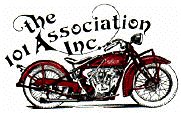Walker machine parts is here: http://walkermachine.com/frontwheelbrakegroup.aspx
From what I can see on the page, Walker doesn't supply readymade brake shoes, but material for relining. Here's a picture on how rivets should look properly done:
http://www.autoandindustrial.co.uk/index.php?webpage=riveting
And a example of tool for that:
https://www.steinertractor.com/MIS1131-Brake-Riveting-Tool
CWS moto has a lot of brake parts and possibly brake shoes if you ask.
http://cwsmoto.com/products/scout?limitstart=0
I found pictures on the Reno site. He doesn't update price or availability on his site, so you have to mail and ask.
http://reno.indianmoto.cz/index.php?id_category=24&controller=category&id_lang=1&p=5
-------------A note regarding the many times excellent repro parts available nowadays. New is good in many cases. Just a little wear (rounding off) of the brake cam both (already round) outer edges diminish the brake efficiency substantially, and wear trenches in the shoe surface where the cam wedge against is lessening the force that the cam can and should exert against the shoes, so that is important areas to look into (fill in and ground flat). Brake cam bushing wear in the shield should not be allowed as it makes the cam tilt. Wear in all those areas together with flex in the brake cable makes the brake spongy and travel range at the handlebar lever too short.-------------------------
Some advocate use regular aluminium pop rivets, I strongly advise against that because the rivet material is soft, hollow through, thin and the clamping force is unknown for various quality pop rivets! Add to that a small ball of steel that is remaining in the rivet that needs to be secured or removed.
http://www.benchmarkworks.com/articles/howto/brake.html
If you want to know more about brake friction materials that should be used for our light weight motorcycles, ask various professionals.
https://custombrakes.co.uk/vintage-and-classic-brakes
https://saftek.co.uk/friction-products-for-classic-vehicles-and-race-applications/
Glue bond the material is well known and safe way if done proper. Some friction materials is only suitable for bonding. If I choose that method I would have a professional shop do that in an oven.
http://adhesives.raybestospowertrain.com/
P.s. I agree with Ken, rivet a lining even if it is bonded.


